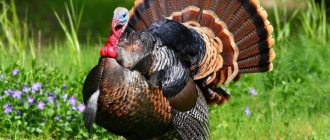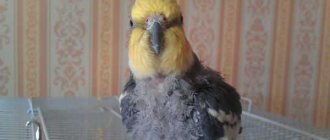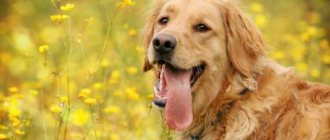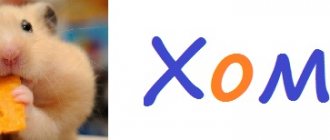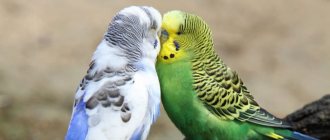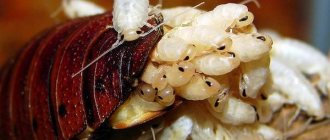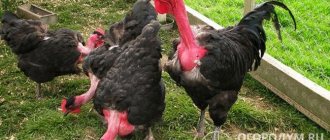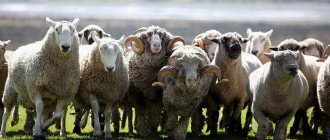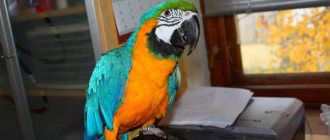- home
- Parrot
- Breeding
04/15/2019 Breeding cockatiels is a fascinating process, where each clutch is different from the previous one. But in order to get healthy offspring, you should take into account some nuances and be prepared for some difficulties.
general description
A medium-sized parrot from the Cockatoo family weighs 100 g. The body size is about 30 cm, the tail length reaches 15 cm, the wingspan is 40 cm. The beak is small, but quite powerful. A distinctive feature of cockatiels is a high crest on the head.
Natural coloring is not very bright; males look somewhat more colorful than females. Chicks at a young age have the same faded coloring as females. Only when they reach the age of puberty do males acquire their characteristic plumage. Usually changes begin to occur from 6 months of age.
Corellas reproduce well in captivity; artificially bred parrots have a wide variety of plumage color options. The most common mutation is lutino. Individuals of this species are yellow in color. They have red eyes and orange cheeks.
Cockatiels live only in Australia. These birds are monogamous. Their breeding season coincides with the rainy season and lasts from October to December. Parrots make their nest in the hollow of a dead tree at a height of 2 m above the ground. The female lays 4 to 7 eggs, one egg per day.
Both parents are equally involved in incubating eggs and feeding chicks. The chicks hatch after 17-23 days and are completely helpless. After 5 weeks, the chicks leave the nest. They reach puberty at 6-11 months.
In the wild, cockatiels live 12-15 years. If kept at home, a parrot can reach the age of 25 years with proper care.
Selecting a pair of cockatiels for mating
Good offspring of cockatiels can only be obtained if both parents are completely healthy, sufficiently mature, and are not close relatives to each other.
Appearance and health
First of all, the selected pair of parrots must have excellent physical and mental health. When purchasing, it is important to pay attention to the external condition of the birds - they should be cheerful, react with curiosity to strangers and to the entire environment in general.
You will probably be interested in reading about how to determine the age and sex of a cockatiel parrot.
Even if there are no visible diseases or injuries (apathy, weakness, inexplicable aggression), the future owner should still be on the safe side - after purchasing, take the new pets to the nearest veterinary laboratory for special avian tests confirming the absence of any inflammatory processes in the body of the cockatiel.
Age
Another important factor is the age of the cockatiel. Despite the fact that these birds are physically capable of breeding from the age of 6 months, it is extremely undesirable for them to breed offspring before the age of one and a half years.
Did you know? Of all the countless species of birds, only parrots can absorb food while holding it in their paws.
Otherwise, young males may simply be infertile, and young females may have problems laying eggs. Unlike the chicks of adult parrots, the offspring of immature young are born weakened and very rarely survive due to the lack of maternal instinct and basic care skills in inexperienced parents.
Not related
Breeding closely related cockatiels (inbreeding) will also be a big mistake. The consequences of such an experiment will probably be the most unexpected and will have an extremely negative impact on future chicks:
- various deformations of the beak, claws, paws, wings;
- painful orthopedic problems;
- impaired functioning of internal organs;
- infertility;
- weak immune system and high susceptibility to diseases.
Check out the common colors of cockatiels.
Features of behavior
When planning to breed cockatiels at home, pay attention to the behavioral characteristics of these parrots. The emotions they experience are clearly demonstrated by the parts of the bird’s body:
- Excitement, alertness - the crest stands upright, eyes wide open.
- Aggression, preparation for an attack - the crest is slightly tilted and pressed to the head, the pupils are dilated, the feathers are ruffled, the tail is loose. The bird clicks its beak and flaps its wings.
- Playfulness - the crest is held straight, lightly touching the back, eyes narrowed.
Parrots have a harsh and unpleasant voice. The more excited the bird is, the higher the voice.
If a cockatiel hisses, it is a sign that it is preparing to attack. A parrot reacts this way if it believes that an attempt is being made to take over its home. You should not stick your fingers between the bars; cockatiel bites are very painful.
Corella is sensitive to affection. She enjoys scratching her head and ruffling the feathers on the back of her head.
Cockatiels are shy. When experiencing stress, untamed parrots can become aggressive when given a new owner. It is better to buy birds from a nursery or from trusted breeders. It is not recommended to adopt an adult, unsocialized bird: it will not be able to get used to its owner and will cause him a lot of trouble.
Intelligence and habits
Among breeders, the Corella parrot is famous for its good nature; they say about it: “affectionate, like a house cat.” They are smart, easy to tame and train, and can learn several dozen human words. True, these birds do not have outstanding vocal abilities: you should not expect clear pronunciation from them. The nymph is able to imitate animals and imitate the noise of operating equipment. In a state of highest pleasure, the parrot sings, whistles in every way, and goes through words from its stock.
Important: Often, a talkative cockatiel with its harsh voice arouses hostility among others. A frightened or angry bird makes very unpleasant, ear-piercing sounds.
The character of a cockatiel is a variable value. A change in behavior may be due to the introduction of a new bird, illness, or the awakening of the sexual instinct. Do not give in to the reciprocal desire to intimidate, shout, or push the bird away. Only with patience and affection can you regain her trust.
When getting a cockatiel, be prepared for the fact that it needs to be raised. An adult that remembers the previous owner has difficulty getting used to its new habitat. The established character and habits of such a parrot cannot be corrected. If you take home a three-month-old chick, it is quite easy to raise an obedient and intelligent pet from it. You just need to work with him from the first day, once the adaptation process is over. A mischievous nymph who trusts her owner is most willing to talk and perform tricks.
The demand for cute parrots is not decreasing - they captivate with their gentle appearance, flexible mind, and calm temperament. It is easy to achieve reciprocity from them if you show goodwill and surround them with care and attention. The best living conditions will help the bird become a full member of the family.
Breeding
Breeding cockatiels is not difficult; As soon as parrots are 6 months old, they are already able to reproduce. But it is better not to subject a fragile organism to such a test and give the chicks the opportunity to grow up to one and a half years old.
In nature, parrots breed in the fall. At home, you can encourage cockatiels to mate by artificially creating suitable conditions for them; for this you need to:
- Find compatible partners.
- Ensure correct lighting conditions.
- Offer complete food.
- Place a nest in the cage.
It is advisable to purchase a spacious tall cage of rectangular or square shape. To breed a cockatiel at home, you need to provide a pair of parrots with a large cage, at least 70x70x150 cm.
Far from civilization
Karelian parrots are native to Australia. They were first described by I. Gmelin, a German naturalist, doctor and botanist, in 1788. And only half a century later, D. Gould, a British ornithologist and animalist, began to study in detail the features of the existence and behavior of these birds.
In the wild, cockatiels live in the plateau region, only occasionally found in coastal areas. They settle in tree hollows where they make nests. After hatching the chicks, the parrots fly in a flock to a new place in search of food.
Parrots' diet consists mainly of seeds of various types of grasses. They really need water, which is why they nest near bodies of water.
Parrots of this breed are considered active birds: they can not only fly, but also move deftly on the ground on two legs. The flights are not very fast, but nevertheless the flocks make long-term flights.
Cockatiels are not afraid of humans. In case of danger, the parrot can fly from the ground to the nearest branch and continue observing what is happening. Catching these parrots is not difficult: they often become the prey of hunters and go for meat or become cage dwellers as pets.
Australian environmental legislation has prohibited the export of cockatiels from the country, so in other regions they are bred in captivity.
In Russia and European countries, these parrots are called “nymphs” and this name is more common. They were once classified as cockatoo parrots, but further scientific research suggests that cockatiels or nymphs are still a separate species. The nymphs are indeed very similar to cockatoo parrots in body structure and, above all, in the coquettish crest on the head.
Compatibility issues
When a pair of opposite-sex cockatiels live together from a young age, and they have no alternative to meeting other partners, their friendships can gradually turn into marital ones. The resulting mutual interest will clearly manifest itself. The birds will sit side by side on a perch and gently touch each other’s feathers with their beaks. The male's readiness to mate is demonstrated by the increased intensity of his chants.
If your pet is raised alone and aggression occurs when a foreign parrot is introduced between the cockatiels, this may be due to increased testosterone levels in the male. A short separation usually solves this problem. If mutual hostility does not go away, you will have to take care of acquiring other marriage partners.
A little history of the species
The homeland of the cockatiel is Australia. Animalist and ornithologist John Gould undertook a zoological expedition to the mainland in 1838-1840. He pulled out about eight hundred birds and seventy animals. Returning to Britain, he systematized his work, culminating in the book Birds of Australia. In the section on parrots, the ornithologist explains everything about the cockatoo: its lifestyle, its appearance.
Europe first saw cockatoos in the 1840s. The spread of these birds in the European part of Eurasia occurred thanks to the efforts of private breeders from Paris. After 1960, Australia banned parrots from leaving the country. Further breeding and selection took place without the participation of wild representatives.
What to feed
When breeding cockatiels at home, parrots are fed well-balanced food. A grain mixture for medium-sized parrots is suitable for this. Additionally, add to the diet:
- grated carrots;
- pieces of cabbage;
- slices of apple, pear;
- plantain seeds;
- dandelion leaves;
- a few drops of vegetable oil;
- sprouted grains;
- honey (2 g 1 time per week);
- boiled egg (2 - 3 times a week, a little).
Honey and butter can be given on a small piece of bread. Birds love to chew on fresh tree branches. The cage must contain special mineral supplements in the form of sand and pebbles.
After the birds settle into the nest for brooding, soft egg food should be excluded from their diet. Its presence stimulates the female to lay more eggs.
When the chicks hatch, the mashed egg becomes their main food and is returned to the feeder. Grown chicks, feeding on their own, switch to the regular diet of parrots.
Parents feed their babies by regurgitating food directly into their beaks. Chicks can be taken from their parents for artificial feeding when their eyes open. This usually happens on days 10–12. The “foster babies” are fed liquid warm porridge made from infant formula. You can also feed “natural animals” in order to accustom them to human hands.
Feeding the chicks
For three to four days, the female feeds the chicks with a yellowish-white liquid - chamois milk. After this time, the cockatiel begins to feed them with the male's semi-digested food.
If the birds, due to overwork and lack of parental instinct, do not start feeding the chicks, they will need help.
Feed your chicks baby formula every two hours. It should be liquid and heated to a temperature of thirty-five degrees. For convenience, use a syringe without a needle.
After a week, start feeding the chicks every three hours. When the baby is two weeks old, add well-prepared liquid millet porridge to baby food. Increase the amount of food you eat so you don't have to feed your children at night. When the chicks are a month old, start feeding them a tablespoon of grain mixture five to six times a day until they begin to eat on their own.
If you have raised cockatoos before, please share your experience with us. Perhaps you have something to add.
If you liked this article, please do.
Requirements for daylight hours
Long daylight hours stimulate parrots to reproduce; for cockatiels it should be at least 16 hours. Before this, the birds are kept on a shortened day for a month, its duration is 8 - 10 hours. During this period, parrots must undergo molting, their gonads are activated.
The required length of daylight can be ensured with the help of additional sources of artificial lighting and dense material thrown over the cage. The parrot needs to add more “day” gradually, 10 minutes every day. Too sudden a change in conditions can negatively affect his sexual function.
Comfortable indoor conditions for the breeding pair are maintained with a constant air temperature of 18–20 °C and a humidity of 50–60%.
How parrots behave during the mating season of cockatiels
Parrots, including nymphs, are characterized by strict monogamy. The male, if he is single, tries to attract the female in one way or another, noticing her from afar. Mating games and mating of males in front of females are quite energetic, and observing their actions is of great interest. The male spreads his tail, slightly raises his wings, puffs up the feathers of his back and head, constantly spins around the “axis”, while emitting melodic and sonorous trills.
The previous idea that a bird sings because it is having fun or that the male is trying to please the chosen female is, of course, not true. The fact is that with his song he attracts the female to the nest, indicating that the place for the nest has been chosen and the offspring can begin to hatch. Singing and displaying increase the male's arousal and are transmitted to the female, synchronizing their activity. This is the biological significance of mating ceremonies in birds. Observations show that the sexual cycle in males begins earlier than in females, who rush to a singing or current male, whose voice makes it easier for her to search and shows that he has already occupied a territory suitable for nesting.
Each pair of nymphs has its own nesting area, on the territory of which they feed and have a hollow. The nesting site is guarded by the male, and the size of the territory depends on his feeding. First, the male selects a hollow, secures the territory around it and protects the area from rivals. After some time, the female, attracted by singing, joins the male. A pair can break up only in one case - if one of the birds dies. Soon all suitable hollows are distributed among the males, and those who did not manage to take a place for the nest in time remain single. An attempt by a single male to approach a hollow occupied by another pair causes energetic rebuff from the owner of the nesting site.
Females appear to move freely around any nesting site, since no aggressive actions are shown on the part of the established pair. Free females do not react to the hollow.
When the hollow is assigned to a pair, the male mates with the female, and she begins to improve the nest.
A hollow is a cavity in the trunk or large branches formed as a result of the destruction of the internal tissues of the tree. A hollow occurs most often due to damage to trees by pests or other reasons. Hollows develop mainly in old, especially overmature and drying trees. A healthy, young and middle-aged tree stand almost does not have them. Parrots are not able to make a hollow either in a damp-growing or even in a dry tree, if its wood is not at least partially subject to destruction.
The hollow is to some extent similar to the ground substrate, but has certain advantages over it. In this regard, nesting in hollows is usually considered as the evolutionarily latest and most advanced type of nesting, since this significantly increases the safety of the offspring. Thus, hollow nesters found themselves in a more advantageous position than birds nesting on bare ground. However, nymphs are to some extent similar to species that nest on terrestrial substrates. They lay eggs directly at the bottom of the hollow without any bedding. Cockatiel chicks are born immature and are of the so-called nestling type, so the nest has two main functions. The first is to be a container for the clutch and create sufficient thermal insulation during incubation of eggs, and the second is to be a container and shelter for the chicks. Naturally, the size of the nest must be such that the brooding female completely covers the nest tray with her body, that is, the size of the tray must correspond to the size of the bird.
Nesting nymphs in hollows allows them not only to increase the safety of their offspring, but also to protect eggs and chicks from precipitation and strong winds; in the hollow there is a smaller amplitude of temperature fluctuations and more constant humidity. However, nesting in hollows, while creating a number of advantages for a particular pair and its offspring, at the same time has a number of negatives.
Source
Arrangement of the nest
A nest placed in a cage serves as a signal to encourage parrots to mate. This process usually takes about a week, but there may be exceptions. A special box is used as a nesting box; it can be bought in a store.
By the behavior of the parents, you can accurately determine when eggs will appear in the nest. The birds alternately perform the duties of a hen: during the day the male takes care of the eggs, at night the female replaces him at post. After 21 days from the moment of laying, the chicks will begin to appear.
What does a healthy bird look like?
Breeding cockatiels is a responsible process. It must be approached very carefully. As stated above, both parents must be healthy.
How to distinguish a healthy bird from a sick one? If the parrots are cheerful, curious, willing to make contact and chirp loudly, they are healthy. At least there are no external signs of illness.
After purchasing, it is recommended to visit an ornithologist. He will examine the birds and take the necessary tests from them. After all the procedures and 100% confidence in the health of the parrots, you can think about breeding.
Source
